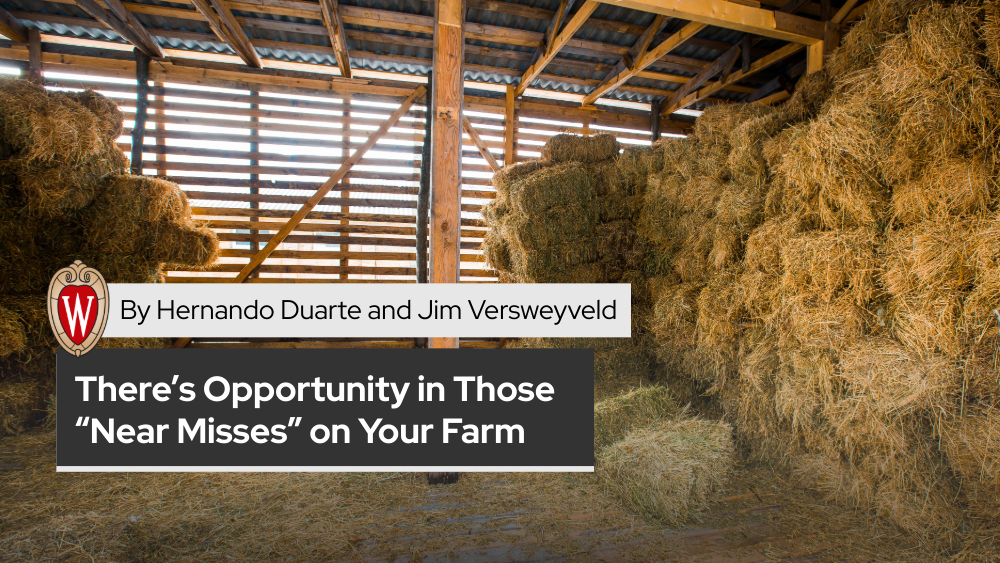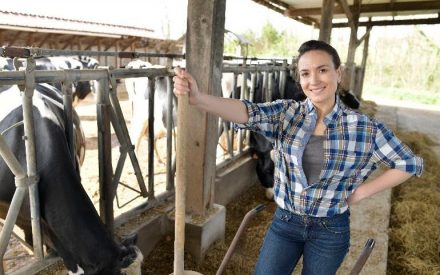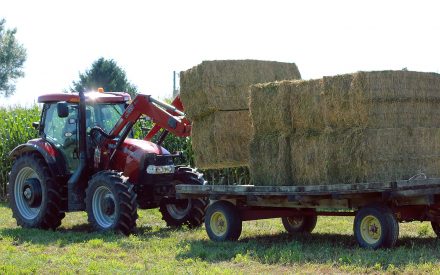Read in: English | Español

Farms are fast-paced, high-demand workplaces where the potential for injury or costly mishap can lurk around every corner. With multiple tasks underway at once, employees of varying experience levels, long hours, unpredictable weather, and often heavy equipment in motion, risks are ever-present. One proactive and often overlooked way to improve farm safety and prevent future injury incidents is through a simple yet powerful practice: reporting and having conversations on your farm about “near misses”.
What is a “Near Miss”?
A “Near miss” is an unplanned event that did not result in injury, illness, or damage—but that had the potential to do so. Sometimes called a “close call” or a “lucky break,” these incidents might seem minor or inconsequential at first. However, they represent a warning sign that something in the process, work environment, or behavior could be improved to prevent a more serious event in the future. In the world of safety, a “near miss” presents an opportunity to learn about prevention.
What Are Some Examples of “Near Misses”?
- A dairy farm employee slips on a wet parlor floor but manages to regain balance without falling and experiencing a fracture or head injury.
- A field worker approaches a tractor and rotating PTO; their sweatshirt sleeve catches on the equipment but tears away harmlessly.
- Large bales of straw are being stacked with a skid steer. A misplaced bale falls, narrowly missing nearby workers.
- A group of farm visitors are touring your new parlor. Unexpectedly, a spooked cow bolts through an empty gate as you exit the parlor and people have to jump aside to keep from getting bowled over.
Although these incidents didn’t cause harm, they could easily have resulted in serious injury or even a death under slightly different circumstances. Rather than brushing these incidents off, these near misses should be treated as learning moments, warning signs to identify and correct hazards, adjust processes, reinforce training, or improve physical conditions on the farm.
Why Reporting “Near Misses” Matters
Many ”Near Misses” incidents go unreported simply because no one was hurt and nothing was damaged. However, this lack of reporting and acting on the incident creates a false sense of security, and it reinforces the idea that current conditions are okay. “Near misses” are often the precursors to serious injuries, fatalities or damage to property. Thus, identifying patterns in these events can reveal systemic issues and conditions that need to be addressed. “Near misses” can serve as a foundation for periodic farm safety and health training with your workforce.
Unfortunately, employees may hesitate to report “near misses” for a variety of reasons:
- Fear of being blamed or disciplined.
- Embarrassment over making a mistake.
- Not realizing the importance of reporting a non-injury event.
That’s why it’s essential to create a workplace culture that treats “near misses” reporting as positive inputs that prevent future accidents. Reporting these incidents should be encouraged or even rewarded.
How to Encourage “Near Misses” Reporting
- Foster a no-blame, no-shame culture: Make it clear to all employees that reporting a “near miss” will not result in punishment. Frame reporting these incidents as a valuable contribution to team safety.
- Thank employees for speaking up: Show appreciation and concern when someone brings a “near miss” to your attention. Let them know you’re glad they’re okay and that you value their input.
- Act on the information: Follow up promptly by addressing any hazards (such as a slippery surface or an aggressive cow) and inform the team of the changes made.
- When you do safety training, make sure to talk about important “close calls”, the consequences that COULD have resulted, and how you (or your team) corrected the situation. This reinforces that reporting DOES make a difference and gives you a chance to show that you are making real investments in safety.
- Make it part of onboarding: Introduce “near miss” reporting as a standard safety expectation during new employee orientation. When employees understand from day one that their observations matter, they’re more likely to speak up later.
Turning “Near Misses” into Training Moments
Here’s how to turn a “near miss” into a meaningful safety conversation and into practical learning experiences, reinforcing awareness and teamwork.
- Document the incident while it’s fresh in your mind. Include what happened, the location, equipment or other involved, environmental factors, and actions that led to the close call. Simplify incident reporting by using a one-page report, check the ‘Near Miss Report Template‘ available to use at your operation.
- Share the story at your next safety meeting without identifying anyone involved (unless they’ve agreed to be named). Emphasize that it’s a learning opportunity—not a critique. Remember that adult learners (your workers) are most likely to learn from effective “storytelling.” The process of sharing presents a great learning opportunity when it comes to safety.
- Engage your team in discussing how to prevent similar events. Ask for ideas and feedback. Could a guard be added? Can the flow of animals be changed to reduce risk? Do you need to be more proactive in requiring the use of PPE with certain jobs? Does a work area need better lighting or signage? Could a new protocol help?
- Reinforce the message that reporting “near misses” is a team effort and helps keep everyone safe.
Building a Positive Farm Safety Culture
Incorporating “near miss” reporting into your overall safety strategy and into your safety policy build a stronger and a more proactive safety culture on your farm. It shows employees that their safety is a top priority and that management values transparency, honesty, and open communication.
By encouraging open communication and prompt action, you not only reduce risk but also build a safer, more resilient team.
Each “near miss” is a chance to prevent a future accident. Don’t miss the opportunity to learn from them.
Updated: July 18, 2025
Reviewed by: John Shutske, Ph.D., Professor and Agricultural Safety & Health Specialist, and Carolina Pinzón, MSc., Bilingual Dairy Outreach Specialist, University of Wisconsin-Madison Division of Extension

 Building a Positive Farm Business Culture: Perceptions of Health and Safety among Latin/Hispanic Dairy Workers
Building a Positive Farm Business Culture: Perceptions of Health and Safety among Latin/Hispanic Dairy Workers A culture of ‘farm safety’ starts with a well-written policy
A culture of ‘farm safety’ starts with a well-written policy The Farm Business Culture
The Farm Business Culture Understanding the Total Compensation Statement Benefits Everyone
Understanding the Total Compensation Statement Benefits Everyone


